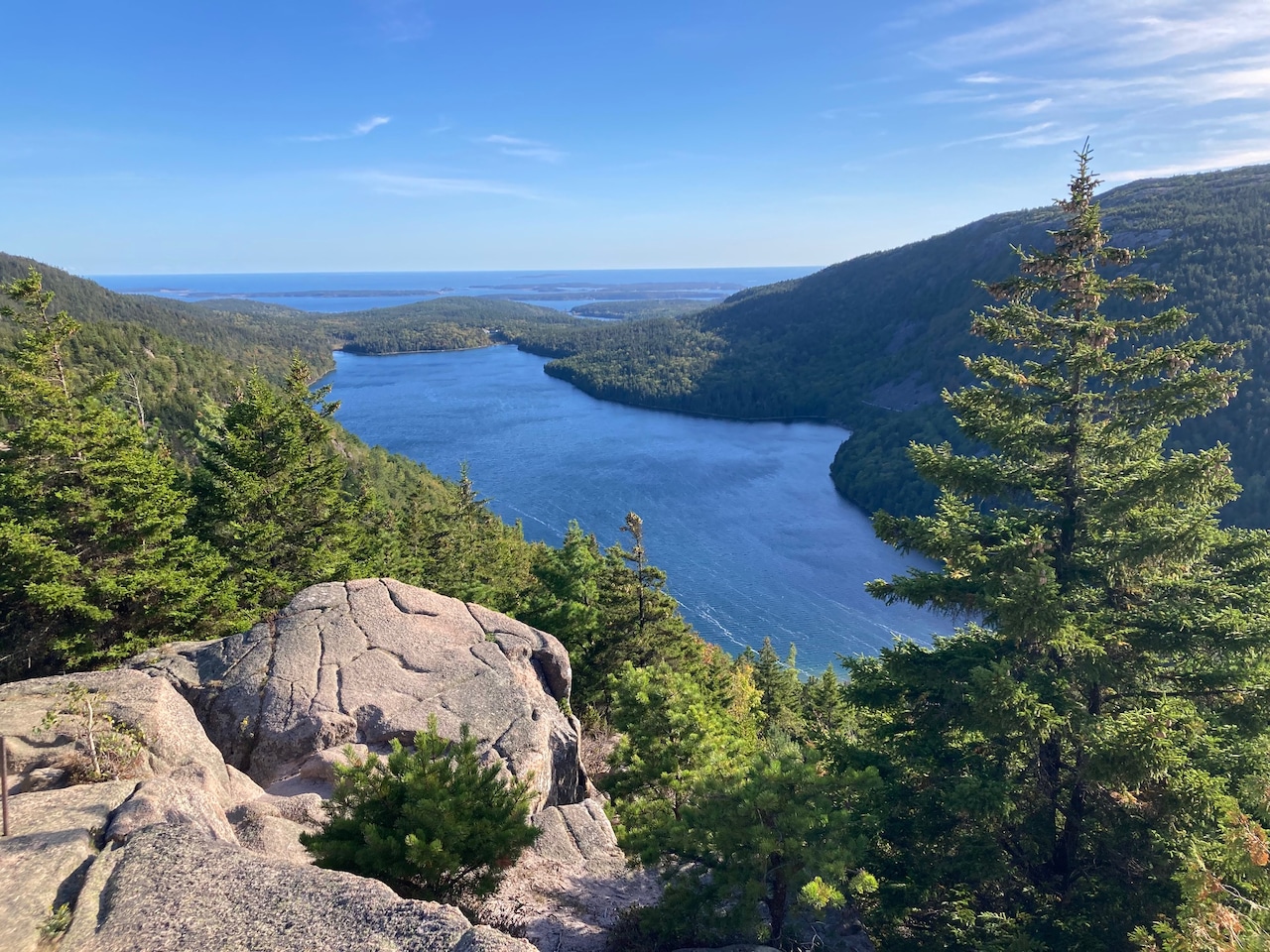First-timer’s guide to Acadia National Park: Jordan Pond, the Beehive, Cadillac Mountain and more

Editor’s note: Travel editor Susan Glaser visited Acadia National Park last month, before the federal government shutdown that started this week. The park is open, but the visitor center and nature center are closed. In addition, the road up Cadillac Mountain is closed to cars during the shutdown.
BAR HARBOR, Maine – We circled the parking lot once, twice, three times. The fourth time around, the attendant waved us in and we were on our way, hiking around stunning Jordan Pond, with a tasty popover as a reward for tired feet.
Yes, there are ways to avoid the crowds at Maine’s Acadia National Park. But on this, my first visit, I was determined to see the top sights – Jordan Pond, the Sand Beach, Cadillac Mountain and Thunder Hole. So I patiently (or maybe not so patiently) circled for parking, tried (unsuccessfully) for sunrise reservations and visited three bike shops before I found a cycle to rent.
Acadia, like many national parks, is setting attendance records this year. In July and August, Acadia exceeded previous monthly visitation numbers set in 2021. September, when I visited, may be the same.
With 3.96 million visitors in 2024, Acadia was the seventh most popular national park in the United States – just ahead of Olympic and Grand Teton and behind Rocky Mountain and Yosemite.
There’s a reason these places are popular, of course: because they’re gorgeous. And so I vowed to concentrate on the beauty — and not the car – in front of me, as I set out to explore the park.
First stop: Sand Beach
With 50,000 acres of wild Maine coastline, granite mountain tops, serene ponds and towering pines, Acadia has been on my bucket list for years. But it’s a haul from Cleveland – 14 hours in the car — and I could never figure out how to make it work.
Then, earlier this year, some longtime friends and I agreed on a September reunion on Cape Cod. I decided to add on a few extra days in Maine.
I had initially planned to drive all the way from Cleveland, but good airfare and cheap rental car prices convinced me to fly into Boston instead. After a few hours at L.L. Bean on the drive north, we arrived at the park in late afternoon, ready to explore. The ranger at the Hulls Cove Visitor Center suggested we head straight to Sand Beach, one of the most popular spots in the park.
It was after 4 p.m., with gorgeous late afternoon sun, and after many visitors had returned to their hotels or campgrounds for the day. After easily finding a place to park, we strolled the beach, framed by granite cliffs on either side, and I dared to put my feet in the water. (“No colder than Lake Erie in May,” I declared to my husband.)
From the beach, we strolled the Ocean Path south to Thunder Hole, a cave in the rocks that makes a thundering clap when water gushes in. We continued to Otter Cliff, another dramatic rock formation, where a group had gathered for sunset.
The Ocean Path, about 2 miles one way, is perhaps the most popular trail in the park, gravel for much of the route, and relatively flat. Much of the path runs parallel to the park’s 27-mile Loop Road, which connects many of Acadia’s top attractions. It’s an easy stroll that provides maximum views without too much effort.
We had the trail mostly to ourselves in late afternoon. The next day, however, we drove past around noon and the path was packed. Do this one late in the day, if possible.
The Beehive, the Bubbles and Jordan Pond
I strove for an early start on our first full day in the park, but it wasn’t early enough. Parking lots near the Beehive, the first hike on our itinerary, were already full when we arrived around 9 a.m. So we circled around and parked along the roadway.
The Beehive is an iconic Acadia trek, a short but steep climb up Champlain Mountain, which is outfitted with metal rungs and ladders to assist in the effort. It also features some rock scrambling and steep drop-offs.
This trail starts with warning – “Falls on this mountain have resulted in serious injury and death” – but don’t be too intimidated. This trail was great fun, offered terrific views and can be accomplished by anyone in reasonably good shape. Don’t miss it.
From the Beehive, we got back in the car and headed to Jordan Pond, where parking (again) was an issue. But parking favors the patient, and eventually we got a spot.
First up: the 3.3-mile loop trail around the pond, one of the most iconic and scenic spots in the park. The trail is flat and easy most of the way, with some rocky areas to maneuver through on the west side, along with a long boardwalk that protects the fragile wetlands.
We rested our feet at the Jordan Pond House, the only restaurant inside the park, known for its terrific views of the water and its fluffy, custardy popovers served with jam. We didn’t have a reservation and waited perhaps 15 minutes for a table, but sometimes the wait can be much longer.
There’s a full menu at the main restaurant, plus a bar serving drinks and popovers. The restaurant, an Acadia tradition since 1893, is open from mid-May through late October.
I had one final hike on my agenda for the day, the Bubbles Trail, and this is the one that nearly did me in, not because it was too tough but because I was too tired. At the north end of Jordan Pond are side-by-side mountains, North Bubble and South Bubble, both of which are accessed on this moderately difficult 1.5-mile trail. The steep ascent, however, was worth it for the views – of Jordan Pond and the Atlantic Ocean beyond.
Biking the Carriage Roads and Cadillac Mountain
I gave my feet a rest on the second full day in the park, renting bikes to check out the Carriage Roads.
The park was founded in 1916, although the area had been a vacation destination for decades prior, popular with many of the nation’s Gilded Age industrialists, including Rockefellers, Fords, Morgans and others.
In 1913, John D. Rockefeller Jr. – the son of the founder of Standard Oil – began developing a system of carriage roads in the area so that he didn’t have to see, smell or hear the region’s early automobiles.
Today, the park maintains 45 miles of carriage roads, with a crushed gravel surface, perfect for biking, with gorgeous routes through forests, past ponds and under historic bridges.
My husband and I rented e-bikes, which I appreciated on numerous uphill stretches. But plenty of folks were riding conventional bikes. (Note: Only Class 1 e-bikes are allowed, with a maximum speed of 20 mph.)
There were also plenty of pedestrians along the pathways, as well as horse-drawn carriage tours, offered by Wildwood Stables.
After the bike ride, it was time to ascend Cadillac Mountain, which, at 1,530 feet, is the highest mountain in the park and along the eastern seaboard. It’s also the only mountain in the park with motor vehicle access to the top.
Cadillac is also the first place to see sunrise in the United States half the year (October through early March).
But getting up there for sunrise is no easy feat.
Since 2021, the National Park Service has required a reservation to drive to the top of the mountain. However, sunrise reservations are typically gone within seconds of being put on sale (30% are available at 10 a.m. 90 days in advance, with the remaining 70% available at 10 a.m. two days in advance). I didn’t have any luck getting a sunrise pass. So I made a reservation for late afternoon on our last full day in the park (cost is $6, at recreation.gov).
Unfortunately, the clear skies from earlier in the day had filled in with clouds, so the view at the top wasn’t as amazing as it might have been. But it was still spectacular.
There’s an easy half-mile hike atop the rocky summit, which provides views in all directions.
You can also hike to the top of Cadillac — there are four trails to the summit, ranging in length from about 2 to 3.5 miles one way. But my feet were grateful for the respite. Maybe next time.
There will be lots on my list for next time – including more hiking and biking and exploring in the lesser-visited Schoodic Peninsula area of Acadia, about an hour’s drive from the visitor center (with ferry service available from Bar Harbor through mid-October).
On our final morning in Maine, we drove over to the western half of the park, which is sometimes called the “quiet side.” I had picked out one final hike – a 1.2-mile loop trail up Beech Mountain – before the drive back to Boston.
Unfortunately, the low clouds from the previous day had stuck around for this hike, which limited what would likely have been incredible views.
The good news, though: We didn’t have any trouble finding a parking spot here.
If you go: Acadia National Park
What: Acadia is located primarily on Mount Desert Island on the Maine coast. The park makes up about half of the island, which also features the quaint town of Bar Harbor, as well as several other communities. A separate, more remote section of the park is located farther east on the Schoodic Peninsula and is considered a great destination for parkgoers seeking to avoid the crowds.
Start your visit at the Hulls Cove Visitor Center, where you can pick up maps and get information on trails, tides and ranger programs.
Park admission: $35 for seven days in a private vehicle; available online or at the visitors center.
Getting around: Parking throughout the park is a hassle during peak season, so consider using the free Island Explorer shuttle service, with several routes through and around the park, operating through mid-October. Details: exploreacadia.com
Where to stay: There is no overnight lodge at Acadia, so most people stay in Bar Harbor, the picture-perfect waterfront town on the east side of the island, surrounded by parkland. There are numerous hotels and inns in town, none of them inexpensive. We stayed three nights at the Holbrook House, with 13 rooms and a terrific morning meal. We paid about $350 per night.
The park also has several campgrounds, including Blackwoods, Seawall, Duck Harbor and Schoodic Woods. Reservations are required at recreation.gov.
Where to eat: Recommended meals in Bar Harbor included dinner at the Side Street Café, Leary’s Landing Irish Pub and Abel’s Lobster on the Somes Sound. Also enjoyed: lunch at Jordan Pond House, to-go sandwiches at Mother’s Kitchen and sweet treats at the Stadium.



